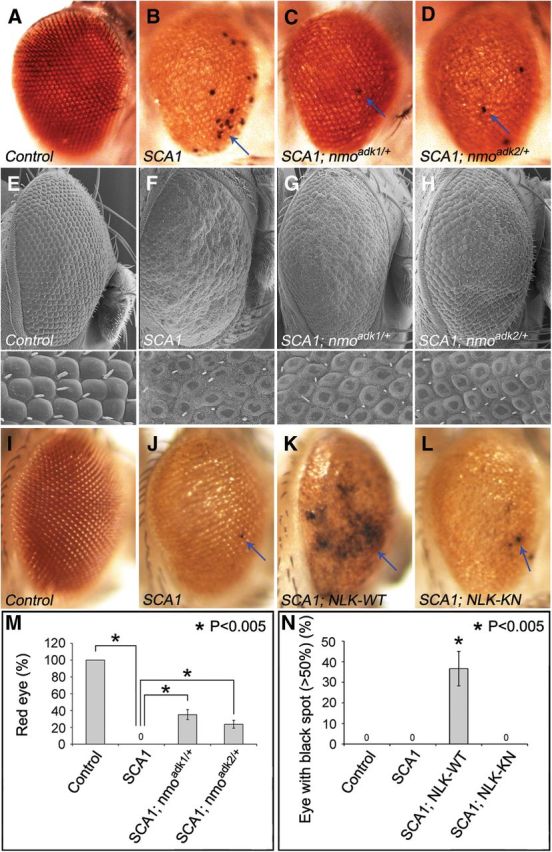Figure 3.

NLK modulates polyglutamine-expanded ATXN1 disease phenotypes in a Drosophila model of SCA1. A–H, Loss of one nmo allele suppressed ATXN1(82Q)-mediated retinal phenotypes. Both light microscopy (A–D) and scanning electron microscopy (E–H) of adult Drosophila eyes are shown, and magnified images are on the bottom of each panel. Two independent mutant alleles (adk1 and adk2) of nmo showed the same results. Light microscopic analysis clearly shows the depigmentation and necrotic death (marked by arrows) phenotypes of the external eyes. Scanning electron microscopy shows the retinal degeneration phenotypes of SCA1 with better resolution. Flies were raised at 27.5°C, and genotypes are as follows: A, E, GMR-Gal4/+; UAS-EGFP/+; B, F, UAS-ATXN182Q/+; GMR-Gal4/+; C, G, UAS-ATXN182Q/+; GMR-Gal4/+; nmoadk1/+; and D, H, UAS-ATXN182Q/+; GMR-Gal4/+; nmoadk2/+. I–L, Coexpression of NLK-WT, but not kinase-inactive mutant NLK (NLK-KN), worsened retinal degenerative phenotypes induced by polyglutamine-expanded mutant ATXN1(82Q). Flies were raised at 27.5°C, and genotypes are as follows: I, GMR-Gal4/UAS-EGFP; UAS-EGFP/+; J, UAS-ATXN182Q/+; GMR-Gal4/UAS-EGFP; K, UAS-ATXN182Q/+; GMR-Gal4/UAS-NLKWT; and L, UAS-ATXN182Q/+; GMR-Gal4/UAS-NLKKN. M, Quantification of the genetic interaction study between loss-of-nmo-function and SCA1 (A–D). A total of 100% of SCA1 flies showed a yellow eye color (thus, 0% showed a red color) and a heterozygous loss of one nmo allele strongly suppressed SCA1 phenotypes, resulting in a red eye color. For this genetic interaction study, flies were raised at 27.5°C and >100 adult eyes per genotype were examined at day 2 after eclosion. Four independent experiments were performed (p < 0.005, t test). N, Quantification of the genetic interaction study between gain-of-NLK-function and SCA1 (I–L). SCA1 flies show patches of necrotic death on the external surface of the eyes, and coexpression of the WT NLK strongly enhances this phenotype. For this genetic interaction study, flies were raised at 27.5°C, collected at day 1, and kept separately at 27.5°C. At day 5 after eclosion, eyes with >50% necrotic black spots were scored. More than 100 adult eyes per genotype were examined, and five independent experiments were performed. *p < 0.005 (t test).
